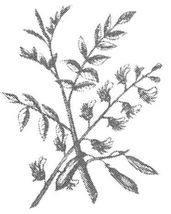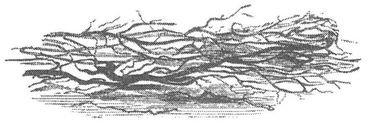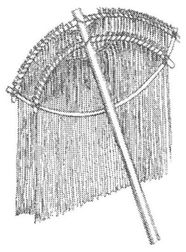Essence and Alchemy (12 page)
Read Essence and Alchemy Online
Authors: Mandy Aftel

Benzoin
is a secretion of the tree
Styrax tonkinense.
The tree does not produce the secretion naturally, however. A wound is inflicted in the bark, sufficiently deep to result in the formation of ducts through which the resinous secretion is produced. When it is hard and dry, the material is collected, in the form of small lumps or tears.
is a secretion of the tree
Styrax tonkinense.
The tree does not produce the secretion naturally, however. A wound is inflicted in the bark, sufficiently deep to result in the formation of ducts through which the resinous secretion is produced. When it is hard and dry, the material is collected, in the form of small lumps or tears.
Benzoin

Benzoin has a soft, sweet, warm body note that evolves into a balsamic powdery
finish and blends with almost anything. It is a good fixative for Oriental scents and, to a lesser extent, florals. It is an inexpensive one, too, and can be used economically to extend a vanilla note. Too much benzoin, however, can suppress the odor of the other ingredients. (It, like civet, can be used to pre-fix alcohol, by adding 2 ml benzoin to I quart of alcohol to marry for a month.) People tend to find benzoin calming, seductive, sensual, and rejuvenating.
finish and blends with almost anything. It is a good fixative for Oriental scents and, to a lesser extent, florals. It is an inexpensive one, too, and can be used economically to extend a vanilla note. Too much benzoin, however, can suppress the odor of the other ingredients. (It, like civet, can be used to pre-fix alcohol, by adding 2 ml benzoin to I quart of alcohol to marry for a month.) People tend to find benzoin calming, seductive, sensual, and rejuvenating.
Peru balsam
, like benzoin, is a pathological secretion produced by wounding the
Myroxylon pereirae
tree, which grows to a height of fifty feet or more in high altitudes in Central America. A mid-sixteenth-century papal bull
64
authorized clergy in El Salvador to harvest and use the precious balsam and pronounced it a sacrilege to destroy or injure the trees that produced it. The document also described the extraction process in detail. An incision was made in the tree, “whence it gradually exudes, and is absorbed by pieces of cotton rags inserted for the purpose. These, when thoroughly saturated, are replaced by others, which, as they are removed, are thrown into boiling water. The heat detaches it from the cotton, and the valuable balsam being of less gravity than water, floats on the top, is skimmed off, and put into calabashes for sale.“
, like benzoin, is a pathological secretion produced by wounding the
Myroxylon pereirae
tree, which grows to a height of fifty feet or more in high altitudes in Central America. A mid-sixteenth-century papal bull
64
authorized clergy in El Salvador to harvest and use the precious balsam and pronounced it a sacrilege to destroy or injure the trees that produced it. The document also described the extraction process in detail. An incision was made in the tree, “whence it gradually exudes, and is absorbed by pieces of cotton rags inserted for the purpose. These, when thoroughly saturated, are replaced by others, which, as they are removed, are thrown into boiling water. The heat detaches it from the cotton, and the valuable balsam being of less gravity than water, floats on the top, is skimmed off, and put into calabashes for sale.“
Peru balsam

The odor of Peru balsam resembles that of vanilla but is not so generally pleasing. It looks like molasses, and because of its dark color was not much used in perfumery but reserved for soap. The natural perfumer, however, should appreciate its color as an essential and beautiful aspect of its character, like the flaws in leather. With its rich, sweet dryout note, the essence imparts a warmth to perfumes, an edible quality. It blends well with petitgrain, patchouli, sandalwood, ylang ylang, labdanum, and tuberose. It smells similar
to tolu balsam except that tolu is slightly spicy, while Peru is slightly floral.
to tolu balsam except that tolu is slightly spicy, while Peru is slightly floral.
Â
Eartby
essences have the musty, stale smell of freshly turned soil. They include vetiver, angelica root, patchouli, oakmoss, and labdanum.
essences have the musty, stale smell of freshly turned soil. They include vetiver, angelica root, patchouli, oakmoss, and labdanum.
Vetiver
is a grass whose rootlets have been used for their fragrance since ancient times. The root itself possesses an agreeable aroma and, when dried, has been used to scent linens and clothes. It was also woven into mats that were sprinkled with water and hung like curtains to cool and scent the air in a dwelling. The oil distilled from the roots is amber-colored and, as described by Arctander, “sweet and very heavy-earthy, reminiscent of roots and wet soil, with a rich undertone of âprecious wood' notes.” Some people find the odor of vetiver too strong straight from the bottle, but it dilutes beautifully, lending a richness to dry-toned blends and the smell of stems and leaves to rose-based perfumes. Vetiver is extremely long-lasting and is an excellent fixative. It blends well with other green and herbal notes as well as with patchouli and sandalwood. Vetiver is grounding and strengthening.
is a grass whose rootlets have been used for their fragrance since ancient times. The root itself possesses an agreeable aroma and, when dried, has been used to scent linens and clothes. It was also woven into mats that were sprinkled with water and hung like curtains to cool and scent the air in a dwelling. The oil distilled from the roots is amber-colored and, as described by Arctander, “sweet and very heavy-earthy, reminiscent of roots and wet soil, with a rich undertone of âprecious wood' notes.” Some people find the odor of vetiver too strong straight from the bottle, but it dilutes beautifully, lending a richness to dry-toned blends and the smell of stems and leaves to rose-based perfumes. Vetiver is extremely long-lasting and is an excellent fixative. It blends well with other green and herbal notes as well as with patchouli and sandalwood. Vetiver is grounding and strengthening.
Vetiver

Angelica
root can be dried and distilled to produce a pale oil with a light, peppery top note and an earthy, herbal body note that is slightly musky and animal-like, with a spicy undertone. It is one of the lighter base notes and lends an astringent and herbal base to a
blend, but its power can easily be underestimated. Each batch must be carefully smelled for variations in concentration. It has a unique tenacity and great diffusive power, and it blends well with patchouli, opoponax, costus, clary sage, vetiver, and oakmoss.
root can be dried and distilled to produce a pale oil with a light, peppery top note and an earthy, herbal body note that is slightly musky and animal-like, with a spicy undertone. It is one of the lighter base notes and lends an astringent and herbal base to a
blend, but its power can easily be underestimated. Each batch must be carefully smelled for variations in concentration. It has a unique tenacity and great diffusive power, and it blends well with patchouli, opoponax, costus, clary sage, vetiver, and oakmoss.
Patebouls
is a dark brown oil distilled from the stems and leaves of the pogostemon plant, which resembles garden sage, but with less fleshy leaves. For many the smell of patchouli is wrapped in memories of the sixties, but in the mid-nineteenth century, it was used to scent Indian paisley shawls and to discourage moths from damaging them. French manufacturers, having discovered the secret of their odor, began to import the dried leaves to perfume knockoffs of their own manufacture, which they passed off as genuine.
is a dark brown oil distilled from the stems and leaves of the pogostemon plant, which resembles garden sage, but with less fleshy leaves. For many the smell of patchouli is wrapped in memories of the sixties, but in the mid-nineteenth century, it was used to scent Indian paisley shawls and to discourage moths from damaging them. French manufacturers, having discovered the secret of their odor, began to import the dried leaves to perfume knockoffs of their own manufacture, which they passed off as genuine.
Patchouli

The odor of patchouli is the most powerful of any essence derived from plants. It has a sweet, rich, herbaceous top note and an earthy, slightly camphorous body note that evolves into a dry, woody, spicy note. As Arctander notes, it will remain perceptible on a perfume blotter for weeks or months, with a sweetness that “is almost sickening in high concentration.” A well-aged patchouli develops a rich, almost fruity note. Patchouli blends well with labdanum, vetiver, sandalwood, cedarwood, lavender, angelica, clove, and clary sage. It also works well with rose, extending and fixing its sweetness. Patchouli imparts strength, character, allure, and lasting quality. It is an aphrodisiac that is also grounding and balancing.
Oakmoss
(
mousse de chêne
) is the soft, treacly, greenish-black lichen
Evernia prunastri,
which grows primarily on oak trees. In its natural state it has no discernible fragrance, but after it has dried and rested for a while, it develops a scent reminiscent of seashore, bark, wood, and foliage. In sparing doses, it lends the scent of a wet forest to the
dryout note of a perfume, giving the whole a naturalness and a rich, earthy undertone, along with great fixation. Oakmoss requires restraint on the part of the perfumer; too much can ruin a creation.
(
mousse de chêne
) is the soft, treacly, greenish-black lichen
Evernia prunastri,
which grows primarily on oak trees. In its natural state it has no discernible fragrance, but after it has dried and rested for a while, it develops a scent reminiscent of seashore, bark, wood, and foliage. In sparing doses, it lends the scent of a wet forest to the
dryout note of a perfume, giving the whole a naturalness and a rich, earthy undertone, along with great fixation. Oakmoss requires restraint on the part of the perfumer; too much can ruin a creation.
Lidanisterion

Labdanum
has been used since antiquity in incense and as an embalming agent. It is the resinous exudation of rockrose (
Cistus ladaniferus
), a small shrub that grows wild around the Mediterranean. Long ago, the oleoresin was collected by shepherds, who combed it from the fleece of sheep that had been browsing among cistus bushes; the first-century Roman writer Dioscorides mentions that it was combed from the beards and thighs of goats as well. In Crete, an instrument called a
ladanisterion
âa sort of double rake with leather thongs instead of teethâwas used to collect the resin. These days, the twigs and leaves of the plant are boiled in water to yield the aromatic gum. (The flowers, which have only a faint scent, are not exploited in perfumery.)
has been used since antiquity in incense and as an embalming agent. It is the resinous exudation of rockrose (
Cistus ladaniferus
), a small shrub that grows wild around the Mediterranean. Long ago, the oleoresin was collected by shepherds, who combed it from the fleece of sheep that had been browsing among cistus bushes; the first-century Roman writer Dioscorides mentions that it was combed from the beards and thighs of goats as well. In Crete, an instrument called a
ladanisterion
âa sort of double rake with leather thongs instead of teethâwas used to collect the resin. These days, the twigs and leaves of the plant are boiled in water to yield the aromatic gum. (The flowers, which have only a faint scent, are not exploited in perfumery.)
Labdanum has a pronounced sweet, herbaceous, balsamic odor, with a rich amber undertone found in few other essences. It works well with oakmoss, clary sage, all the citruses (especially bergamot), lavender, and opoponax, and it is particularly useful as a fixative in ambery blends. Labdanum is comforting and centering.
Â
Green
scents are fresh and leafy. They include tarragon, lavender concrete, clary sage concrete, flouve, elderflower, and deertongue.
scents are fresh and leafy. They include tarragon, lavender concrete, clary sage concrete, flouve, elderflower, and deertongue.
Tarragon
, with its sweet and spicy, aniselike scent, is one of my favorite oils; I use it as often as I can. The oil is a pale yellow-green liquid that turns dark yellow and viscous and more resinous as it ages. (Like the citruses, it is perishable and should be stored in the
refrigerator.) Tarragon blends well with galbanum, lavender, oakmoss, angelica, clary sage, lime, fir, juniper, and bois de rose.
, with its sweet and spicy, aniselike scent, is one of my favorite oils; I use it as often as I can. The oil is a pale yellow-green liquid that turns dark yellow and viscous and more resinous as it ages. (Like the citruses, it is perishable and should be stored in the
refrigerator.) Tarragon blends well with galbanum, lavender, oakmoss, angelica, clary sage, lime, fir, juniper, and bois de rose.
Â
Edible
essences are associated with food. This family includes vanilla, black tea, green tea, cognac, coffee, and cocoa.
essences are associated with food. This family includes vanilla, black tea, green tea, cognac, coffee, and cocoa.
Vanilla
plants are orchids, vines that climb along tree trunks. Their seed pods exhale one of the finest odors in the vegetable kingdom. The culture and preparation of vanilla involves a kind of alchemy, however. The seed pod has no fragrance when it is gathered, but develops its characteristic odor as it ferments during the curing process, under the sorcery of sun and air. As the lower end of the pod begins to turn yellow, it releases a penetrating scent of bitter almonds. Cracks open in it, releasing a small quantity of its oil, which is known as balsam of vanilla. By degrees the color darkens, the flesh softens, and the true odor of vanilla begins to develop as the natural fermentation gradually progresses up the pod, which takes about a month. The essence is exuded in thick reddish drops. The pods are processed in various ways to give us vanilla oil and vanilla extract.
plants are orchids, vines that climb along tree trunks. Their seed pods exhale one of the finest odors in the vegetable kingdom. The culture and preparation of vanilla involves a kind of alchemy, however. The seed pod has no fragrance when it is gathered, but develops its characteristic odor as it ferments during the curing process, under the sorcery of sun and air. As the lower end of the pod begins to turn yellow, it releases a penetrating scent of bitter almonds. Cracks open in it, releasing a small quantity of its oil, which is known as balsam of vanilla. By degrees the color darkens, the flesh softens, and the true odor of vanilla begins to develop as the natural fermentation gradually progresses up the pod, which takes about a month. The essence is exuded in thick reddish drops. The pods are processed in various ways to give us vanilla oil and vanilla extract.
Other books
The One For Me (Danver #8) by Sydney Landon
The Professor by Charlotte Brontë
Memory Wipe (The Gene Thief Series Book 3 - Short Story) by Cole, Jason
Tying One On by Wendi Zwaduk
Scion of Cyador by L. E. Modesitt Jr.
The Perfect Prey by James Andrus
Her Alpha Lover: A Draken and Charli Boxed Set by Richensexi, Amanda
Dirty Play: Sports Romance by Paige, Violet
The Walking Stick by Winston Graham
